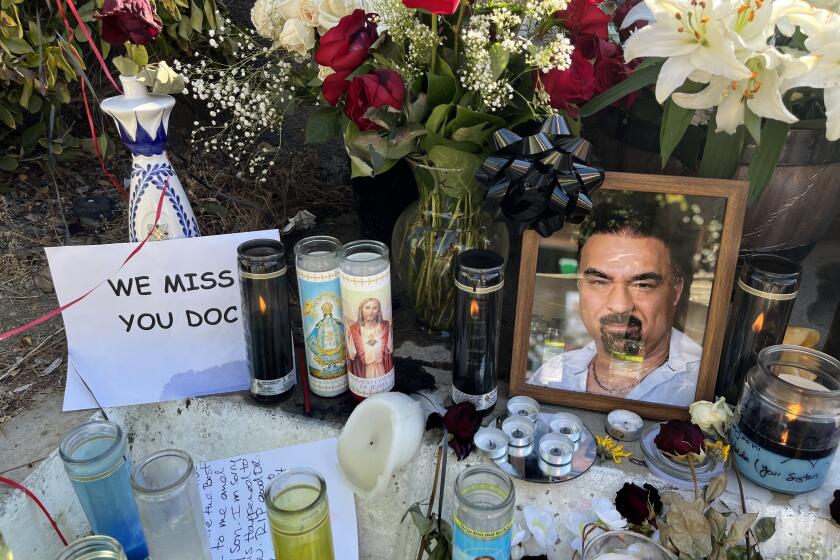Skid row bathrooms are a perennial debate
Facing a growing number of homeless people, Los Angeles housing officials agreed in 1992 to put dozens of portable toilets throughout skid row, only to have Mayor Tom Bradley cut off the funding.
Alice Callaghan, an activist for the poor, then arranged for six outdoor latrines festooned with ornaments and garlands for Christmas. The mayor had them hauled away.
Two years later, Bradley’s successor, Mayor Richard Riordan, had two dozen portable toilets placed on skid row. Half were yanked in 1998, then returned after a protest. But in 2006, the city, with Mayor Antonio Villaraigosa in charge, had them all carted off for good.
Bathroom politics on skid row have long had an absurdist tinge, part Keystone Kops and part Groundhog Day, as the city has wrestled with how skid row’s homeless residents should meet their most basic needs.
More than 1,000 people who sleep outdoors in the 52-block district, and 2,500 who join them during the day, rely on five self-cleaning toilets, social service agencies and a couple of park restrooms that are locked overnight. The streets reek of urine. And it seems everybody has a story of witnessing someone using the “box,” as the neighborhood is known, as an open-air restroom.
The latest evidence of chronic problems with the city’s skid row bathroom strategy came last month, when county officials warned of an immediate public health threat.
During two inspections in May, survey teams found human or animal waste piled at 14 sidewalk locations. Most of the $250,000, self-cleaning toilets were out of order, said the report by the Department of Public Health, which “strongly recommended” the city install more public restrooms.
“What is most critical in the … survey findings is the continuing lack of access to fully operable and sanitary public restrooms for homeless residents in the skid row area,” the county’s June 5 report said.
City officials said the toilets often break down but are repaired regularly. After a similar negative report last year, the city earmarked $1.2 million this year for quarterly sanitizing and spot cleaning of skid row sidewalks and streets, though there is no commitment to provide additional toilets.
Councilman Jose Huizar, who represents skid row, is studying bathroom access for homeless people in the neighborhood, a spokesman said.
“Unsanitary conditions on skid row are unacceptable,” said Mayor Eric Garcetti’s spokesman, Yusef Robb. “We want to stay focused on why there are people in the streets.”
The problem is that public toilets — particularly ones used by mentally ill or addicted people — are perennially trashed and used for prostitution or substance abuse.
Some downtown business leaders say more bathrooms are not the answer. They argue that new toilets, like the old ones, will be colonized by prostitutes and drug users.
Estela Lopez, executive director of the Central City East Assn., says addicts and alcoholics are mired in a “culture of lawlessness” and won’t quit using the sidewalks, no matter what the city does.
“It goes on all day, every day — they choose not to use bathrooms,” she said, adding that the only solution is to get people off the streets.
Advocates for the homeless say the city should get rid of the criminal behavior, not the bathrooms.
“When [pop singer] George Michael was arrested for soliciting in the park bathroom in Beverly Hills, we didn’t shut the bathrooms down,” said attorney Carol Sobel, who has filed several lawsuits against the city on behalf of homeless people.
The advocates maintain that business interests, abetted by the city, are using the bathroom crisis to drive out homeless people so downtown can continue to gentrify.
“It’s all about the real estate,” said Callaghan, the longtime head of Las Familias del Pueblo, a social service agency on 7th street.
Jennifer Wolch, dean of the College of Environmental Design at UC Berkeley, who has studied homelessness in Los Angeles, agreed.
“It’s not just about the toilets,” Wolch said. “It’s about wanting to have homelessness go away and be somewhere else.”
Los Angeles’ automated toilets are made by JCDecaux, a French company that supplies high-end units to cities worldwide. From the outside, the sleek cabinets — painted with Gallic flair in forest-green with gold trim — resemble street kiosks or subway depots.
Inside, metal sinks and porcelain bowls flip back through the wall into a hidden closet, where they are washed and dried after each use. Floor nozzles power-wash corrugated metal floors. Automatic doors slide open if someone tries to linger too long.
The toilet at 5th and Los Angeles streets records 128 flushes a day, or one about every 11 minutes. The city says they’re being used as they should be, as bathrooms.
But one day this month, as two LAPD officers shot by on their stand-up three-wheelers, a man and a woman disappeared together into the cabinet at 5th and San Julian streets.
Greg Taylor, 56, lived on the streets of skid row for four years. Back from Long Beach to visit friends, he said, “If they bring more bathrooms, they’ll just be places for people to go to use drugs.”
Los Angeles police Capt. Horace Frank said human waste outside his skid row station, just blocks from City Hall, is so bad that downtown business owners power-wash the sidewalks outside the police station every two weeks.
“A lot of tents go up behind us, and people are not all going to walk all the way to a bathroom,” said Frank, who heads up the LAPD’s central area.
Frank, however, said police have dropped their objections to the bathrooms since the city cut the time people can hide inside from 20 minutes to 10.
“The issue isn’t [whether] we should have them,” Frank said. “The issue is we can’t have people spending 30 and 40 minutes in them.”
At a quarter-million dollars apiece, acquiring more of the automated models could be difficult. They were provided about six years ago by JCDecaux and CBS Outdoor in exchange for the rights to sell ad space on city transit shelters and kiosks. The 20-year contract called for up to 150 of the bathrooms citywide, but the ad revenue never supported more than a handful, officials said.
The city also pays social service agencies to open their bathroom doors overnight to homeless people. Union Rescue Mission pulled out after one of its security guards was beaten, but Lamp Community, which serves mentally ill homeless, said the program works. Individuals not only used their showers and restrooms, they also stuck around for other services, Chief Executive Donna Gallup said.
“It does really help get people off the streets,” Gallup said.
Some community members are hoping for a creative solution. Portland has reported success with Portland Loo, a $90,000 public toilet with louvered slats strategically placed to make it hard to hide furtive activity. San Francisco is experimenting with a composting toilet.
“This can’t go on,” said Katherine McNenny, a garment district patternmaker who lives in a skid row loft. “We as a culture have given up.”
[For the Record, July 31, 2013: An earlier version of this article gave an incorrect base price for the Portland Loo.]
More to Read
Sign up for Essential California
The most important California stories and recommendations in your inbox every morning.
You may occasionally receive promotional content from the Los Angeles Times.









